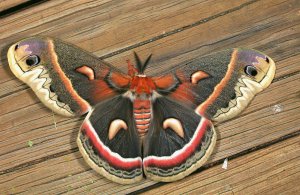 Holiday Fun Around the World!
Holiday Fun Around the World!
Cecropias!
Posted
|
Views: 1,414
By Sam Ortiz
The largest moth in North America is the cecropia. These moths are part of the silk moth family and can be anywhere from five to six inches in wingspan. Cecropias are said to be common, but you may not see them often because they are nocturnal.
Their wings are a grayish-brown color with the base of their forewings being the same red color as their bodies and having an orange stripe near the edge and an orange teardrop shape closer to the center. The edge of the forewing has a wavy white line and a black circle.
The hindwings of the cecropia look very similar except for the absence of the black dot and a white stripe directly above the orange one.
Its antennae are, just as all moths’ are, feathered. The body of the cecropia is a bright red color accented with white and dotted with black down the sides of its furry-looking abdomen.
Moths are commonly known to have scales on their wings, but what about that fur you see on some kinds’ bodies? This “fur” is actually just more scales. Research has shown that these scales can absorb sound and allow them a better chance against predators that use echolocation, like bats.
However, even if a cecropia manages to avoid death by bat, it won’t live for long. Cecropias can only eat when they are caterpillars. Cecropias, and a few other kinds of moths, lose their mouth during their metamorphosis. Cecropias cannot eat and can only live for about two weeks.
In those two weeks that a cecropia is fully grown, it only has one objective: to find a mate. Cecropias can lay up to 100 eggs in a batch, though most won’t survive until adulthood.
Cecropia caterpillars right after they hatch are black. As they go on and molt a few times, they grow in size and eventually change colors to green. Then, when they are ready, they spin their cocoon and begin the cycle again.
The life of a cecropia may not be very long, but these beautiful bugs are much more than the stereotype of the ugly and plain-looking moth everybody knows.

Beware of the Cecropias!


 Magazine Posts
Magazine Posts Table of Contents
Table of Contents